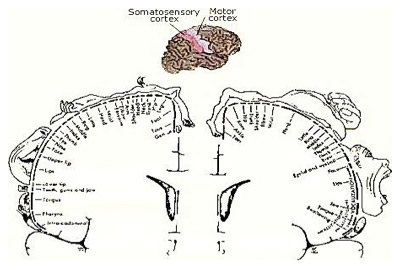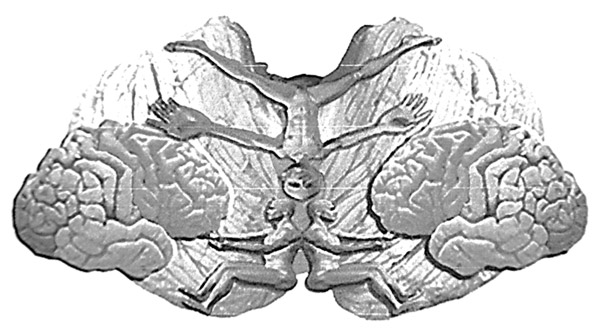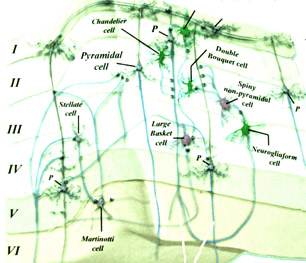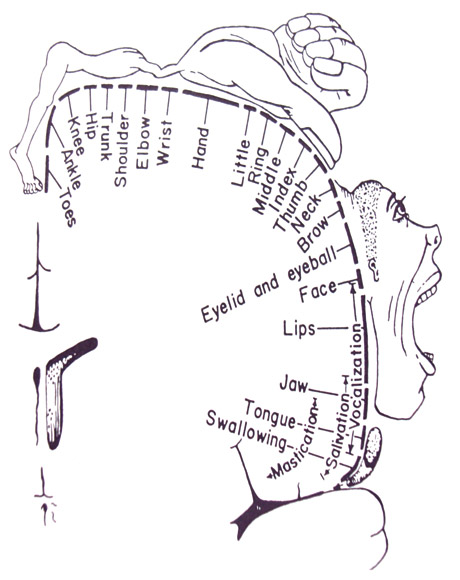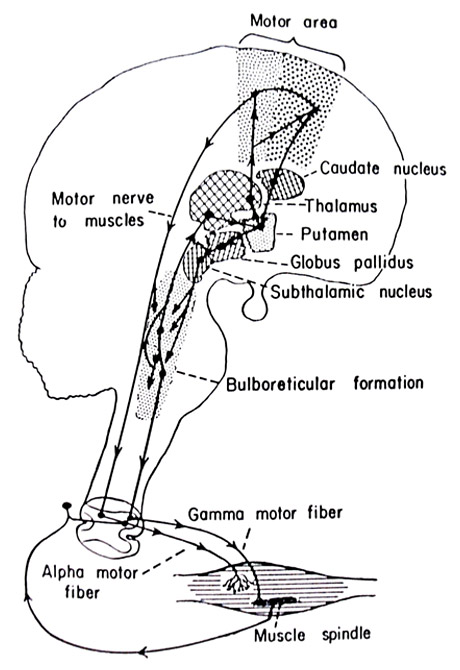Neuro Training
NEURO TRAINING
CONTEMPORARY FUNCTIONAL NEUROLOGY TREATMENT ADVANCEMENTS:
THE ENGINEERING OF HUMAN MACHINES
By Dr. Gilbert S. Jaudy, DC, FACFN, FABVR, CCST
Introduction to Neuro Training for Sports Medicine                               back to NEURO TRAINING
This synopsis comes from years of clinical experience and treatments of various athletes sports injuries as they were restored to human machines.
Sports allows us to use our physical body in a unique and complex way, which most of the time we take it for granted. What we don’t often realize is that behind the uniqueness and complexity of human function lies the brain. A unique and complex organ that controls and regulates every living cell in our bodies. It is the generator of electrical power to your entire system, and the processor of every voluntary and non-voluntary movement that you think of doing or attempt to do.
Sports needs timing, balance, endurance and precision. These four essential qualities can be amplified when the athlete gets the proper, targeted brain-based treatments and training, thus sharpening the skill, increasing endurance and precision that culminate into the THE ENGINEERING OF HUMAN MACHINES.
The Impact of Brain Function on Athletes’ Precision
The Role of the Cerebellum on the Athletes Coordination
The Power of Electrical and Chemical Brain Signals on the Athletes’ Physical Performance
What Happens When an Athlete’s Body Goes Wrong?
What Happens to Your Ambitions and Athletic Spirit When All The Treatments Fail?
Management of Sports Injuries Vs. Restoration of Peak Performance
How Functional Neurology Prevention of Sports Injuries IS key?
Functional Neurology Treatments for Athletes…The Missing Link
The Impact of Brain Function on Athletes’ Precision          back to TOP
One of the brain’s main functions is to let us know where we are in space and where space is in relationship to us. We are hard-wired to every structure in the brain for ultimate focus, precision, prompt attention, and correct responses to what is happening around us. The ultimate source of brain information is the integrity of visual neural pathways and their intact, and speedy connections with brain centers. These centers are by turn hard- wired to our entire musculoskeletal system.  So, anytime we see a target, set on a target, or even think of initiating a movement, the brain fires instantaneously to the entire neurological and chemical structures of the human body, setting the stage for an action.
If this complex system (the nervous system-brain and spinal cord) is working properly, then any athletic move is measured, assessed and accurately performed, thus minimizing to eliminating both the athlete’s exposure to serious injuries, and increasing the athlete’s precision and physical performance.
Recent studies of functional MRI imaging in human beings and recordings of activity on single neurons (brain cells) in monkeys have shown the activity related to eye movements can be found in almost every corner of the brain. Leigh and Zee. The Neurology of Eye Movements. Oxford University Press, 2006. Anytime brain pathways and connections fail to receive accurate information from the visual neuronal network, then  performing an action or attempting a body movement becomes distorted, lost, or injured.
Take a look below at the body’s topographical map (homonculus distribution) in the brain (figure 1).
Figure 1 shows the representation of the human body in the brain (homunculus distribution)
The brain processes raw data to extract information about the structure of the environment, the speed of the movement, the assessed and pre-measured distance, and the precision of the action. Next it combines the processed information with information about the current situation and generates motor response patterns that are suited to maximize the output of the individual. These signal-processing tasks require intricate interplay between a variety of functional subsystems, which can be assessed, evaluated and treated by a doctor who practices Functional Neurology.
It is crucial for athletes around the world and their teams to understand the depth of this vast contemporary science (Functional Neurology) not only for their precision, athletic spirit and ambitions, but also for their brain-body integration as human machines.
The Role of the Cerebellum on the Athlete’s Coordination          back to TOP
A couple of questions to:Â Basketball players, Baseball Players, Tennis players, Hockey players, Football players, Golfers, Soccer players, Volleyball players, Sprinters, Gymnasts, Cyclists, Skateboarders, Ice skaters, various other physical, water, combat, motor, cue, dance, and mind sports.
- Â How important is it to an athlete to consistently win the game, the championship, the title, the gold medal, the endorsements, the wealth, the glory, yet stay neurologically connected?
- How important is it to an athlete to maintain balance, coordination, and muscle tone, yet prevent terminal injuries?
Well, if the answer is “it is very importantâ€, then every athlete should realize that in order to achieve all the ambitions and maintain health, he or she needs to be neurologically wired.
Let’s get a little technical and explain what “neurologically wired†means. We discussed earlier
“The impact of Brain Function on Athletes’ Precisionâ€; now we’re going to understand the role of the cerebellum on an athlete’s professional career and personal health.
The cerebellum (Latin for little brain) is a region of the brain that plays an important role in motor control, and movement-related functions.
The cerebellum contributes to coordination, precision, and accurate timing (important to athletes?). It receives input from sensory systems and from other parts of the brain and spinal cord, and integrates these inputs to fine tune motor activity. The cerebellum is also concerned with the regulation of muscle tone and mechanisms that influence and maintain equilibrium.
Let’s recap. The cerebellum is concerned with, motor control, coordination, precision, accurate timing, fine motor activity, regulation of muscle tone and equilibrium; all the hard-wired functions that an athlete needs for keeping the gold medal.
Because of this fine-tuning function, damage or short circuits to the cerebellum produces disorders in motor control, coordination, precision, accurate timing, fine motor activity, regulation of muscle tone and equilibrium, fine movement, posture, and even motor learning.
Take a look below at the body’s topographical map in the cerebellum (figure 2). Any movement of any limb or body part has to have the precise wiring system, otherwise a desired action can either be delayed, distorted, or missed.
Figure 2 shows the representation of the human body in the cerebellum
The cerebellum is subdivided into three zones, the vermis, paravermal, and lateral. The vermis receives visual, auditory, vestibular, and somatic (body) sensory input from the head, neck and proximal regions of the body, i.e. the vermis is the region that corresponds to the muscular coordination of the spine, trunk, shoulders and hips. It is responsible for axial (midline) and proximal motor activity as well as the ongoing execution of movement. The paravermal or intermediate region receives somatic sensory input from the distal regions of the limbs (arms, forearms, hands, and digits). It controls distal motor activity as well as the ongoing execution of movement. The lateral zone receives input exclusively from the brain (cerebral cortex), and it is responsible for the initiation of movement, planning of the movement, and timing.
Let’s recap. The three zones of the cerebellum are responsible for motor activity, the initiation of movement, planning of the movement, timing and the ongoing execution of movement. These facts become the pivotal point of any athletic movement, training and timing. A faulty cerebellum can distort movement, make training inefficient, increase risk of injury and lag timing, which can be very costly.
Many athletes get injured on regular basis and sometimes permanently. Through the science of Functional Neurology, a trained doctor is able to evaluate your cerebellar function and prescribe specific treatment applications and cerebellar activities to maximize accuracy of motor function, timing, precision, and integrity of the neurological wiring system, yet reducing the risk of sports injuries.
The Power of Electrical and Chemical Brain Signals on the Athletes’ Physical Performance
The cerebral cortex is comprised of six distinct layers.
Layer I used to transfer associated signals to other associated brain regions
Layer II contains cells that function as intra-brain association fibers.
Layer III is comprised of cells that project into the cerebral white matter as association or commissural fibers.
Layer IV is concerned with incoming sensory afferent signals from the thalamus and the brain.
Layer V contains axons that enter the white matter of several brain structures that are concerned with movement, vital centers, autonomic activity, and spinal control.
Layer VI is comprised of fibers (arcuate association fibers) connecting the brain regions together.
Schematic of the six layers of the brain.
Electrically and functioning much like a uniquely designed electric conduit, the brain actually encodes stimuli from the body as nerve impulses. When the electrical impulses reach the brain, they trigger the release of messenger chemicals, such as glutamate, which in turn induce electrical impulses as they travel from one neuron (brain cell) to another. Light, sound and odors, for example, are transformed by our sensory organs into a code made of series of electrical impulses that travel along neurons from the body to the brain. Information about the onset and the intensity of a stimulus is sent to the brain by the timing and frequency of these electrical impulses.
A group of neurobiology researchers at the University of California reported that “Each neuron literally ’picks’ the type information it is supposed to process, that it is competent for. Very much like each musician in an orchestra only reads that part of the score of a symphony that was written for his or her own instrument.â€
The group discovered that different neurons in the brain are dedicated to respond to specific portions of the information. They also uncovered that “each of these specialized brain neurons has a highly branched structure where many neurons carrying sensory information can form connections. At any moment, each of these specialized brain neurons might be receiving multiple messages from multiple sources, but is only selectively responding to certain information about the timing or frequency of the impulses it is receiving.â€
Obviously, timing of information is so important. During any sports activity, any game, or any finale, brain timing defines loss or victory.
Chemically, a single neuron (brain cell) connects to thousands of other neurons through synapses. Synapses are a freeway system in which chemical messengers known as neurotransmitters, travel between neurons. After its release, a neurotransmitter crosses the synapse and activates a receptor protein in the outer membrane of the receiving neuron.
This majestic network of neurons underlies our perception of where we are in space and where space is in relationship to us. It also underlies our ability to set, target, and execute a precise motor movement. But, what happens when this electrical and chemical network misfires?
What Happens When an Athlete’s Body Goes Wrong?             back to TOP
Recent studies supported  Neuronal Plasticity where neurons are able to travel great distances from their mother nerve cells, and function based on the surrounding signals given by other neurons. In other words, they are very adaptable, and are not programmed by DNA for specific functions. Neuronal plasticity is a revolutionary medical discovery as it suggests that this degree of flexibility in the brain could lend itself to further advancement of consciousness, among other things. Functional Neurology is a combination of contemporary science, technology and treatment advancements that facilitate Neuronal Plasticity and brain remapping.
The brain is connected to all your internal structures which control every single physiological and chemical function of your organs, muscles, joints, ligaments, blood vessels, and hormone balance to name a few. That’s why when something goes electrically, chemically wrong or physically, an athlete can instantaneously as well as gradually develop downward loss of physical integrity and connections; resulting in an eruption of a cascade of symptoms which become a kinetic chain or a domino effect. This is termed Neuro-Degeneration—a progressive death of a population of neuron cells that have lost a common function in order to accomplish a certain body task. I see all types of athletes in my practice that not only lost their ambitions and trophies, but have also lost their health and quality of life. Some of the athletes that are reading this information might say, well it isn’t happening to me because I’m young, a winner and healthy. You’re right, but what happens when your body goes wrong? and…What Happens to Your Ambitions and Athletic Spirit When All The Treatments Fail?
What Happens to Your Ambitions and Athletic Spirit When All The Treatments Fail?
For years or decades, you have been to the most prestigious medical centers in the world and have seen the most respected specialists.
For years or decades, you have taken several medications, done many injections, and had your share of surgeries and rehabs, without achieving your expected improvements. Have all avenues failed???
You lost your athletic career, spirit, triumph. and your quality of life. You feel overwhelmed with symptoms, medications, and doctors’ visits, and now you become labeled with SOME disorder, symptom or condition, and your quality of life is going down and you are losing it.
If this hits home, you know exactly what I’m talking about. Let’s look at the bright side and discuss contemporary treatment advancements in Functional Neurology that can help reboot your nervous system (Brain and spinal cord) thus restoring your hard drive to normal processing ability and bring you back into the ring.
Conventional thought is that your shoulder pain is in your shoulder and it has nothing to do with anything else. In reality, your brain is the engine of your body and every part of your body is recognized and controlled by your brain. If any body part does not get INTACT information from brain neurons (cells) and pathways, it will fail or decrease in task. The reason for the emphasis on the word intact in this section is to the targeted brain-based applications in Functional Neurology.
The advanced treatment applications of Functional Neurology are a healthcare revolution at the FOREFRONT OF MODERN SCIENCE. Non-invasively and without drugs, Brain-based treatment procedures and diagnostics have emerged to provide athletes and patients with the relief they’ve NOT been able to find elsewhere…and this has been the missing link in healthcare.
Symptoms such as lack of energy, fatigue, poor digestion, bloating, difficulty expressing what you would like to say or adding and subtracting, memory problems, concentration difficulties, irritability or anger, lack of enthusiasm, skin rashes, heart palpitations, weight gain, muscle and joint weakness, stiffness, and much more are blinking signs of the inability of the nervous system to send and receive accurate physiological information. The reason why there are so many symptoms and no end in sight is because chasing symptoms is like chasing your shadow…there IS NO end.
Everyday our treatment center receives calls from all over the world from athletes and people who have been frustrated by years of pain and suffering and are losing hope. Our advanced treatment applications target the causal mechanisms of suffering, pain, and dysfunctions that lead to progressive disease.
So, if all the treatments have failed do not lose hope, because Brain- Based Functional Neurology treats differently.
Management of Sports Injuries Vs. Restoration of Peak Performance   back to TOP
Sports injuries can be classified as either traumatic or overuse injuries. Traumatic injuries account for most injuries in contact sports such as Football, Rugby, Hockey, Wrestling, Boxing, Kick-Boxing, Karate, Marshal Arts, etc because of the dynamic and high collision nature of these sports. These injuries range from bruises, muscle strains and/or tears, ligament sprains and/or tears to fractures, concussions and head injuries.  Overuse injuries such as Golfer’s elbow, Tennis elbow, Muscle Cramps, ACL Sprains, Ankle Sprain, Shin Splints etc.
Normally ports injuries can be treated and managed by using the P.R.I.C.E.S… DR. ABC, and T.O.T.A.P.S regimes:
P – Protect
R – Rest
I –  Ice
C – Compression
E – Elevation
SÂ – Â Stabilize
Â
D – Danger
R – Response
A – Airway
B – Breathing
C – Circulation
T – Talk
O – Observe
T – Touch
A – Active movement
P – Passive movement
S – Skills test
All this is necessary at first, but what would you do when managing your injuries stops working?
Before we go into details and solutions, please refer to the sections above “The impact of Brain Function on Athletes’ Precision†and “The Role of the Cerebellum on the Athlete’s’’ Coordinationâ€. In these sections we clearly discussed the representation of the human body  (topographic map) in the brain and cerebellum.Â
If you read carefully, you will find that all your limbs and body parts are wired to your brain, so without going into complex neurology and tissue injury mechanisms, it is fair to say that an injury to any body part is and injury to the representation of that body part in the brain. Let’s take a little further, since the brain works on electrical and chemical signaling and in harmony, then an injury to that topographic area will create a domino effect that can spread to your entire nervous system and cause endless cascade of global symptoms that you might not think of associating these symptoms with you site or sites of injury. To take it a little more further, your doctor might tell you that whatever symptoms you’re having now are not related to this or that injury. If that’s the case, then the question in your mind should be. Does my shoulder, elbow, wrist, knee, ankle, foot or any other body part have a life on their own?  It does not.  Then, how do you manage that?  You cannot manage your sports injuries, or symptoms for too long with drugs, surgeries or injections, before the injury site or other areas of your system fail to repair.
Whether a child, an adult, or an elderly, the brain knows no age, the brain knows FUNCTION. You can be five, ten, twenty years old, and be very ill; or you can be ninety years old and be pretty functional. It all goes back to your brain’s electric health and functional neurological pathways.  The brain is the only organ that separates vibrancy from illness, health from sickness alertness from dullness, speed from slowness, quality of life from gradual loss of life.
A common complaint that I hear on daily basis is, “doctor, I am not able to function!†Do not get into the circle of managing symptoms such as chronic injury pain, lack of energy, fatigue, poor digestion, bloating, difficulty expressing what you would like to say or adding and subtracting, memory problems, concentration difficulties, irritability or anger, lack of enthusiasm, skin rashes, heart palpitations, weight gain, muscle and joint weakness, stiffness, and much more… because these are blinking signs of the inability of the nervous system to send and receive accurate physiological information.
A little background for simple understanding: As I mentioned in previous sections, the brain consists of tissue called white matter and gray matter. White matter is that part of the brain made of cells so that nerves can communicate, and operate INTACTLY. Gray matter, using a computer network as an analogy, can be thought of as actual computers themselves. White matter can be described as the tissue THROUGH which messages pass between different areas within the nervous system. So, white matter is the actual network cables connecting the computers together, allowing messages to pass quickly from place to place. It is a super highway of connectors. So, rather than managing your health, Functional neurology treatment advancements address these brain networks, and can help you restore your health and your peak performance for a vibrant athletic return.
It doesn’t actually hit home until you personally are led out of the viscious cycle that seems to be unyielding. After the first few Functional Neurology treatments, and many times only the first, does hope of normalcy return. How could this be?  Is this truly a miracle or is it an explainable science? MIT neuroscientists have now found evidence that the brain has a network of silent connections that responds to input of information and changes at unsuspected speed—measured within two seconds in the adult brain.  The conclusion is that your athletic career is not finished, your health is not deteriorated, and your options are not limited. Latest studies in active research in Functional Neurology has now made it possible to be able to assess the physiological INTEGRITY of the nervous system, and access the brain in order to restore lost and misfiring electrical networks.
What does that mean for the Athlete that suffers with chronic pain from a debilitating injury?   With the strong understanding of the behavior of a nerve cell in different regions of the nervous system, the doctor can aim to target the problem and monitor response to the treatment more precisely an accurately.
I have observed patients with chronic pain syndromes with joints that tend to dislocate such as a hip joint or knee on and off again for years be amazed at the stability and lasting results after a neurological correction when the body part is addressed as it is represented in the brain. THIS IS THE RESTORATION OF PEAK PERFORMANCE. This is sports medicine in Functional Neurology.
How Functional Neurology Prevention of Sports Injuries IS key? Â Â Â Â Â Â back to TOP
In some cerebellar dysfunctions and brain hemisphericities (weak sides of the brain) muscle stretching is contraindicated, because it can encourage speedy muscular, ligamentous, and joint injuries. Most athletes are encouraged to stretch their muscles about one hour before the game and one hour after the game. For some athletes this type of activity can cause a speedy injury to a muscle, ligament or joint that is not properly getting the right electric signals from the brain, or has exceeded metabolic capacity of the neurological pathways that govern the regulation of that muscle, ligament or joint.
What is the scientific rationale behind this knowledge. Please take a look at this schematic (figure 4 ) below taken from Guyton’s book of Medical Neurology. You probably are wondering what you’re looking at. Let’s explain.
The most important ultimate role of the brain and spinal cord is control of bodily activities. This is achieved by controlling (a) contraction of skeletal muscles throughout the body, (b) contraction of smooth muscle in the internal organs, and (c) secretion of both exocrine and endocrine glands in many parts of the body. These activities are collectively called motor functions of the nervous system, and the muscles and glands are called the effectors because they perform the functions dictated by the nerve signals. Figure 4 illustrates the motor axis of the brain and spinal cord for controlling skeletal muscle contraction.
Figure 4 shows the degree of representation of the different muscles of the body in the motor cortex.
Figure 5
Let me make it simple (although it’s not). What neurologically happens in this illustration (figure 5) is that if a muscle undergoes stretching, then a nerve receptor in the muscle called the muscle spindle becomes stimulated and transmits nerve signals through a nerve fiber into the spinal cord all the way up to the brain. At this point the muscle that has been stretched contracts. Contraction of a stretched muscle puts a neurological, physiological, and chemical load on that muscle, weakening (a) its contractile fibers, (b) its muscle spindle signaling and, (c) its wiring center in the brain, resulting in excess muscle output from an already fatigued muscle electric circuitry and an already feeble nerve transmission and conduction with the brain. The result is faster exposure to serious injuries, and slower tissue healing.
All athletes around the world need to realize that the way we are wired is very powerful, yet very complex and accurate. Unnecessary, random or clinically irrelevant stretching of a muscle or group of muscles can accelerate the failure of the wiring system, and speed the exposure to injuries. If you have sustained a sport injury or injuries, then it hit home.
The science of Functional Neurology can determine the areas of the brain that are misfiring, overworking or underworking, and prescribe individualized specific brain-based activities, and pre-game exercise regimens for every athlete’s neurological status and type of sports passion he or she embraces.
Functional Neurology Treatments for Athletes…The Missing Link      back to TOP
When electronic computers were first designed, they all had input circuits which were comparable to the sensory division of the nervous system and output circuits which were comparable to the motor division of the nervous system. In the conducting pathway between the inputs and the outputs were the mechanisms for performing the different types of computations.
In the brain, reception of the input signals and transmission of the output signals is determined by (a) the neuronal processing mechanisms, (b) the information that had already been stored and, (c) the programming unit, which determines the sequence of computational operations.
Figure 6 illustrates a block diagram which demonstrates it similarity to nervous system. These components which are analogous to the to those of the human nervous system demonstrate that the brain is basically a complex computer that continuously collects sensory information and uses this along with stored information to compute the daily course of bodily activities.
Figure 6
As computers are rebooted, repaired or reprogrammed so is the human brain. The difference is that the human brain with its neurological and wiring complexity supersedes that of a machine, however, with the technology and the treatment advancements of Functional Neurology, the missing link is found and human machines can be realized.
From the Decade of the Brain to the forefront of advancements in modern science Functional Neurology has brought breakthrough functional clinical applications and understanding on how the brain works by accessing the hard drive of the brain.
Hard wired brain centers that automatically regulate our breathing, heart rate, sleep cycle, muscle tone, movement, thoughts, awareness, precision, coordination, timing, decisions, etc. as well as pain control.
With the strong understanding about the behavior of a nerve cell in different regions of the nervous system, the doctor can aim to determine and target the problem and monitor response to the treatment more precise and accurately.
During examination, simple tests such as pupilary dilation, bilateral blood pressure evaluation, cerebellar testing and brain function challenge gives the doctor insight into the efficiency of circuits and pathways throughout the brain and nervous system. When this synchronized autonomic nervous system is not functioning optimally, problems can arise to any of the following systems, cardiovascular (blood flow to and from the heart and brain), Respiratory (breathing), Gastro-intestinal (digestion and elimination), Uro-genital (urination and reproduction), Musculoskeletal (muscle and joint function), Vestibular ( balance and vertigo? ), as well as vision and hearing.
I have had many patients with chronic pain syndromes or joints pain that have dealt with their symptoms for years, even decades. Athletes who not only lost their athletic place but their quality of life for years, be amazed at the stability and lasting results after a neurological correction.
Athletes are no short of human machines that can go wrong. The advancements and technology of contemporary sports medicine in Functional Neurology help you meet your health and sports goals so that you can merge them into prevention, stamina, precision, and victory.
By Dr. Gilbert S. Jaudy, D.C., F.A.C.F.N. Â Â Â Â Â Â Â Â Â Â Â back to SPORTS MEDICINE IN NEUROSCIENCE

